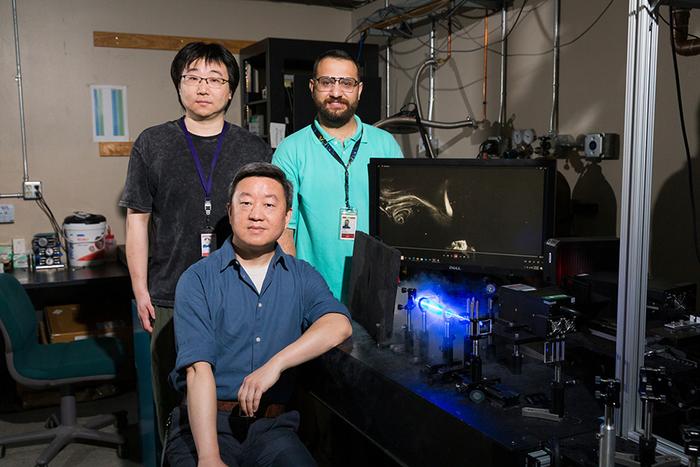In a groundbreaking international collaboration, scientists from the FAMU-FSU College of Engineering, the National High Magnetic Field Laboratory, and several esteemed European institutions have uncovered a universal principle governing the enigmatic behavior of microscopic whirlpools known as quantum vortices. This discovery not only advances our fundamental understanding of vortex dynamics within superfluid helium but also sheds new light on turbulent flows in the classical fluids that surround us every day.
Superfluid helium is a remarkable state of matter that emerges as temperatures approach absolute zero. At these extreme conditions, helium exhibits zero viscosity, allowing it to flow without any resistance—a phenomenon that defies conventional fluid dynamics. Unlike ordinary liquids where vortices manifest as swirling eddies of various sizes and strengths, the rotation in a superfluid is restricted to quantized vortices. These are essentially ultrathin, hollow tubes in which the circulation is fixed and governed by the principles of quantum mechanics. Each vortex carries an exact quantum of circulation, making these structures astonishingly stable and offering an unprecedented window into the natural world’s most chaotic phenomenon: turbulence.
Professor Wei Guo, a leading physicist at the FAMU-FSU College of Engineering, illuminates the significance of these quantum tornadoes: “Their stability and discrete nature mean we can track the dynamics of vortices with much greater precision than was ever possible in regular fluids.” Indeed, this exceptional stability transforms quantum vortices into powerful probes, enabling researchers to decode the intricate processes that orchestrate turbulence—one of physics’ most notorious and complex puzzles.
The key breakthrough emerged when Guo’s team and their international partners, including collaborators from Newcastle University, Lancaster University, Côte d’Azur University, and Italy’s Mauro Picone Institute, succeeded in directly visualizing and analyzing the reconnection events of quantum vortices. These events occur when two vortices collide, merge momentarily, and then separate. Historically, such interactions have been difficult to observe or quantify due to their fleeting nature and minuscule scales. However, by injecting tiny frozen particles of deuterium into the superfluid helium, the researchers effectively illuminated these otherwise invisible vortices. Using a laser sheet and a high-speed camera, they captured detailed, high-resolution footage of the vortices’ movements and reconnections.
Their observations revealed a striking feature: vortices separate at a velocity greater than their initial approach speed following reconnection. This irreversible behavior, described as time-asymmetry, is a fundamental trait of how energy propagates within fluids, whether quantum or classical. “This discovery underscores a universal physical law that governs vortex behavior,” explains Guo. “Despite differences in scale and context, the underlying mechanisms of energy transfer during vortex interactions are shared across seemingly disparate systems.”
The implications of this revelation extend far beyond the arcane world of quantum fluids. Turbulence governs phenomena as vast as atmospheric weather patterns, oceanic currents, and even the aerodynamics of aircraft. Understanding the universal physics of vortex reconnections hence offers a pivotal advantage for scientists seeking to refine predictive models and optimize engineering designs. The study’s elucidation of energy bursts generated during vortex reconnections, which ripple through the surrounding fluid, highlights mechanisms that could inform the management of turbulent flows more broadly.
Interestingly, these energy bursts propagate in patterns reminiscent of cardiac rhythms sending waves through biological tissues, suggesting a deep connection between fluid dynamical processes and natural oscillatory systems. When multiple reconnection events occur in concert within complex vortex networks, they can trigger distinctive quantum turbulence—a phenomenon with unique features absent in classical fluids. Studying such behavior opens new avenues to understand turbulence on both micro and macro scales.
Yiming Xing, postdoctoral researcher and collaborator on this project, emphasizes the practical value of this research: “Quantum vortices behave in a highly controlled, topologically protected manner, making them ideal model systems to study turbulence in its purest form. By leveraging these insights, future innovations could arise, ranging from the design of more efficient engines to enhanced quantum system engineering or even improved models for meteorological forecasting.”
The interdisciplinary and international nature of this research embodies the collaborative spirit propelling modern scientific advancement. Partnering institutions across the United States, the United Kingdom, France, and Italy brought complementary expertise and resources to bear on this challenging problem. Such cooperation highlights how pooling sophisticated experimental setups, theoretical frameworks, and computational modeling capabilities is critical for unraveling complex physical secrets.
This pioneering work has been supported by prestigious funding from The Gordon and Betty Moore Foundation, the U.S. Department of Energy, and the National High Magnetic Field Laboratory. These investments underscore the importance placed on foundational research with the potential to influence a broad spectrum of technological and scientific fields.
Looking ahead, the research team envisions expanding their exploration of vortex dynamics to other exotic quantum fluids and more complicated vortex networks. Unraveling the nuances of vortex reconnection events in various fluid systems could refine our understanding of universal physical laws even further, bridging quantum and classical perspectives. Such advances promise transformative impacts across physics, engineering, and beyond.
In essence, this landmark discovery pulls back the veil on the hidden choreography of quantum vortices, offering unprecedented clarity into the turbulent forces shaping both the minute and massive. As science ventures deeper into the quantum realm, the boundary between abstract theory and tangible application continues to blur, charting an exhilarating path ahead for the understanding and control of turbulent flows in all their forms.
Subject of Research: Quantum vortex reconnections and universal behaviors in superfluid turbulence
Article Title: Experimental and theoretical evidence of universality in superfluid vortex reconnections
Web References:
Proceedings of the National Academy of Sciences
Image Credits: Scott Holstein/FAMU-FSU College of Engineering
Keywords
Fluid dynamics, Superfluid helium, Quantum vortices, Turbulence, Vortex reconnection, Quantum fluids, Classical fluids, Energy transfer, Universal physical laws, High-speed imaging, Computational simulation, Quantum mechanics




